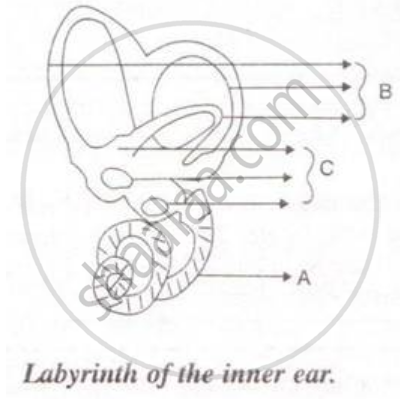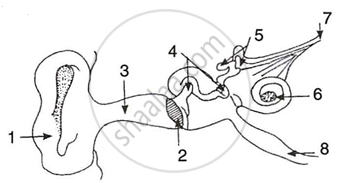Advertisements
Advertisements
Question
Describe the structure and function of the human ear?
Solution
- The outer and visible part of the human ear is called pinata (curved in shape).
- It is specially designed to gather sound from the environment, which then reaches the eardrum (tympanic membrane) through the ear canal.
- When the sound wave strikes the drum, the vesicles move inward and outward to create the vibrations.
- These vibrations are then picked up by special types of cells in the inner ear. From the inner ear, the vibrations are sent to the brain in the form of signals.
- The brain perceives these signals as sounds.

Human Ear
APPEARS IN
RELATED QUESTIONS
fill in the blanks with suitable functions: Ciliary body and __________.
Name the following:
The ear ossicle attached to the tympanum.
Differentiate between members of the following pair with reference to what is asked in bracket.
Semi-circular canal and cochlea (Senses perceived)
Where is the oval window located? Briefly mention its function.
Given below is a diagram of a part of the human ear. Study the same and answer the question that follow:

Name the parts labeled A, B and C in the diagram.
Draw a labeled diagram of the inner ear. Name the part of the inner ear that is responsible for static balance in human beings.
The following diagram refers to the ear of a mammal.

(i) Label the parts 1 to 10 to which the guidelines point.
(ii) Which structure:
(a) converts sound waves into mechanical vibrations?
(b) Converts vibrations into nerve impulses?
(c) Responds to change in position?
(d) Transmits impulses to the brain?
(e) Equalizes atmospheric pressure and pressure in the ear.
Give reason:
Three small bones of ear ossicles are advantageous as compared to one single bone for hearing.
- Draw a neat and well labelled diagram of the membranous labyrinth found in the inner ear.
- Based on the diagram drawn above in (i), give a suitable term for each of the following descriptions:
- The structure responsible for hearing.
- The sensory cells that help in hearing.
- The membrane-covered opening that connects the middle ear to inner ear.
- The nerves that carry impulses from the ear to the brain.
- The tube which equalises the air pressure on either side of the ear drum.
The figure given below shows the principal parts of a human ear. Study the diagram and answer the following questions.
 |
- Label the parts 1 to 8.
- State the role of parts 6, 7 and 8.
- Why is it harmful to use a sharp object to remove ear wax? Mention the number and name of the part involved.
